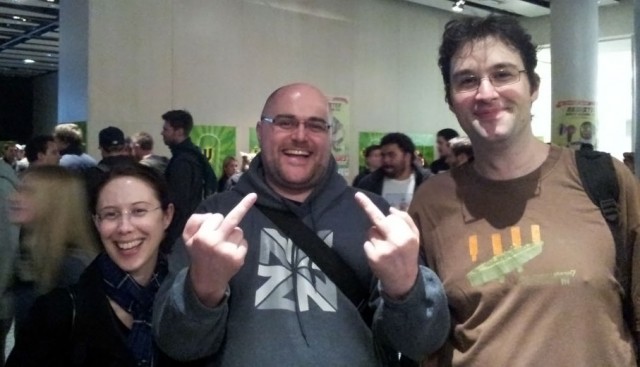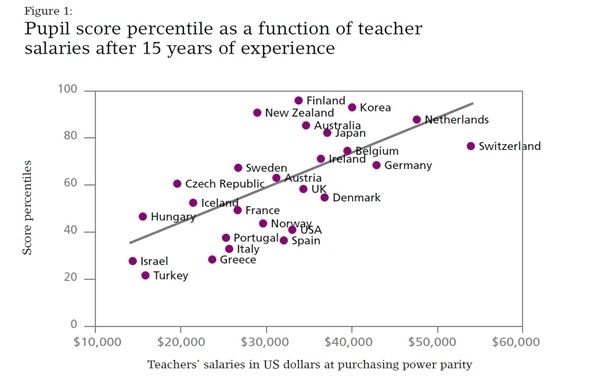Another year down, another short film in the can.
Today I’ll talk a little about my history with 48hours, and my experience competing this time around. After my short has been screened I might also write about my production design, decisions, specific problems, and so on – but for today I’m going to stay away from anything that might be a spoiler.
If you’re not familiar with the V48HOURS event, it brings somewhere between 700 & 800 teams of enthusiastic amateur and professional filmmakers together on a Friday evening, who are locked away in a room in each of the main centres, given a randomly selected genre, as well as a required character, line of dialog, prop, and special technical element, then sent away at 7pm to make a film. You can’t write or shoot anything in advance, no one is allowed to be paid for their work on the film, and it has to be delivered before 7pm on Sunday evening. Deliver at 7:00:01 and you’re out of the competition.
In my opinion, the competition shouldn’t be the point of participation. With so many talented people working their hearts out the prospects of standing out at all, let alone placing is very small. So you should do it for fun, or because you want to challenge yourself, or you just shouldn’t do it at all.
I used to compete with a bunch of old friends in a team called Fractured Radius. They’d been going for a few years before I joined them, and they’d done quite well a couple of times but I told them that if they ever wanted to win, I’d help out. I like to think it’s no coincidence that the first time I helped write, we won the Auckland competition. But it probably is a coincidence.
That’s me and the girl at the starting line, on Friday night, along with dear friend James Brown, who this year finally joined me in breaking away from the Fractured Radius mothership and started his own team.
In 2010, because I wanted to direct, and because I generally had creative & process differences with the team, I left Fractured Radius, this was a hard decision, both because Fractured Radius is a great team full of my friends, and because it’s incredibly well resourced, but sometimes you really do just have to build your own thing.
So I formed my own team Ladies, oh ladies, and got a different group of friends together to have some fun and make a movie.
It didn’t go very well.
The film we made was called Action Manu.
[vimeo]http://vimeo.com/11035444[/vimeo]
I’d love to make a lot of excuses, but the reality is I couldn’t work with the genre (biopic), and wrote a meandering story with an incredibly weak ending. My direction was also very weak, partly because I was new at it, but also partly because I was working with such dear friends, so instead of telling people what to do, I just let things happen. Still, that genre.
Not knowing what you’re going to make is part of the challenge, but along with that comes the risk that you’ll get something you’re completely unsuited to.
Anyway, my self-criticisms would take a hundred posts to detail, so let’s just say I had a great time working with my friends, and it was a huge learning experience.
Last year, 2011, I got a completely different group together, and we made a film I’m extremely proud of, a very challenging, and very polarising film called Kill Therapist.
[vimeo]http://vimeo.com/24344425[/vimeo]
I’m not going to drop spoilers on my own film here, but please be aware that my assigned genre last year was revenge, and I made sure to give my protagonist a reason to want revenge. People who are very young or of a nervous disposition shouldn’t watch.
Some people really loved it, but many people didn’t like it at all.
Everyone who dislikes it has their own reasons. Fair call. I’m a harsh critic myself. If you didn’t like it, tell me about it, I’ll listen. But I’m absolutely certain that some of the people disliked it because they misunderstood something. And that is they actually think I was trying to make a comedy.
If I’m being funny, you’re laughing.
Fact.
But I’ve heard that criticism from a bunch of people now, so I’m certain that misperception hurt the film. I actually find it inexplicable. I wonder if it’s simply because there’s an expectation set up by the nature of the 48hours comp, most of the films in the comp are funny, that was the expectation, so that was the reality.
I’ve actually been told that I should be ashamed of taking the subject so lightly. I didn’t think I had, but once a film is out there, other people get to load their own interpretations onto it.
That’s part of the bargain of producing creative work.
Regardless of the criticism, like I said, I’m extremely proud of that work. I think I performed well as an actor. The whole team did a perfect job. I had more fun than I’ve ever had in 48hours.
But once again the ending wasn’t quite right – not as bad as Action Manu, but it still didn’t build right, and it didn’t really pop.
The problem there is really threefold, firstly there was no time to put it into the storyboarded sequence, it was never intended to be linear, secondly I didn’t follow the time tested structure for this type of film (with that type of revenge film there’s usually an act that follows the recovery & training/preparation for vengeance), and lastly I had to cut some scenes from the end – there was a sequence we shot that was going to play interspersed with the credits – that would have really capped the film off, but it required a lot of special effects, so it just had to go.
So that’s Kill Therapist. Work I’m very proud of which garnered a very mixed response. Where do you go from there?
Where I decided to go, this year, was go it completely alone. To ramp the difficulty up to another level. To see if I could actually find my breaking point. You see, as difficult as the challenge of v48hours is, it’s never beaten me, so I’d gotten cocky. I thought that the only risk I was taking was to make work that I didn’t like, I didn’t think that I’d ever actually fail.
So, I opted to go solo, but in the end I was joined by Selena, and we really made a great team.
My normal process is much the same as many others’, brainstorm & write on Friday, storyboard & get props on Saturday morning, shoot for as long as it takes, then edit on Sunday.
I don’t think there’s an alternative that will produce a good film. I know some people start shooting on Friday night, but I need to take some time to write and get everything in order.
This time around I’m certain that I had the best writing experience I’ve ever had doing 48hours, after a little disappointment with my genre (Urban Legend), I realised that it was actually the broadest genre available this year, that I could essentially make whatever I liked. So I did. It was great fun.
And I was still so cocksure, that I really took my time on Saturday, I went out to a cafe for breakfast with Selena, drew my storyboards (storyboards are an important part of my process, I don’t know how anyone can make a film without them), and didn’t actually start shooting until Saturday evening.
I think we shot for 6 or 7 hours. Which isn’t so bad really, though we did get interrupted a couple of times by a helicopter hovering around nearby which was incredibly frustrating.
Then I made a long cut, with all my favourite one or two takes of each shot, in storyboard order, before heading to bed about 7am and got about 3 hours of sleep.
But the edit was the worst.
I’d shot 46 green screen shots, so in addition to the usual editing all of them had to be keyed and composited. Even with the invaluable help of Selena prioritising my production order (working through the storyboard to find all the shots that required the same work, etc), it was clear by mid-afternoon that it was going to be tight, and then in short order it was obvious that it wasn’t going to work at all.
I’d set myself an overwhelming task, and was being whelmed in all kinds of bad ways.
At 3:20pm, while waiting for a yet another green screen shot to render I sent a simple yet mournful text to Dylan, team lead of Fractured Radius.
Pretty sure I’m not going to make it.
By 5:00pm I was miserable, and nearly broken. I knew that my funny, silly, sweet short wasn’t going to be anywhere near completed, but I was desperate to make it work. So I persisted.
I asked Selena to see what we could cut that would maintain some semblance of coherence, to have any continuity, and she figured out a possible way forward. It would require cutting perhaps 60% of the story.
But there was something else that needed doing as well, along with the other required elements, every film has to have a team introduction included. It’s one of the very few things that you’re actually allowed to prepare in advance, but for whatever reason, I hadn’t made one.
According to the timestamp on the file, I loaded the footage from the camera and audio recorder at 6:10, and had the intro green screened, audio synced, and text added on the end and rendered just 3 minutes later.
It was now about 6:15pm and it was time to try to put Selena’s rescue plan into action. I cut out a lot of scenes. Deleting work that had taken me hours to complete earlier in the day. I cut some scenes shorter to exclude sequences that I knew would no longer make any sense, and I moved some things around a little bit.
I wanted to make sure it worked, but there was no time to watch it through. There wasn’t really time to do anything. I put the required credits on the end, dropped my intro into the timeline, and hit render.
It was 6:47pm and as I watched the final render bar filling up I sent Dylan another text.
49%. Cut most of the funny stuff. Wish me luck.
It was obviously impossible to get it to the Aotea Centre by 7pm, but Selena went and got the car out and said she’d be waiting by the front gate.
The render finished at 6:48. I copied my film to a USB stick, then bolted for the door, ran down the stairs rather than risking waiting for the lift, and hit the gate at a run. Selena was right outside, I jumped in the car “go, go, go!” it was like I was running for my life.
She hauled ass.
I’d been thinking about this route for hours, knowing that no matter how well things went it would be incredibly tight. I hadn’t ever counted on the worst case scenario, but now I was living it.
There are 10 sets of lights between my home and the finish line. Ask me how I know. I was watching the clock in the car tick up. 6:54 we’re at a red. 6:56 we’re at another red.
By 6:58, after the fastest and most nervewracking drive into town I’ve ever experienced we were at the intersection into the Civic carpark, another red light. But I’d already decided what I’d do if we came to this point. So I jumped out of the car without hesitating and ran for it. Straight down the ramp, past all the “NO PEDESTRIAN” signs, straight past the entry gate, and through the carpark.
I knew I only had seconds to make it, so I was running as fast as I could. It was that speed where you know that if you go even the slightest bit faster you won’t be able to keep up with yourself and will take a header. I pushed on.
Rounding the final corner out of the carpark. I could hear the huge crowd inside screaming and shouting. But I couldn’t hear the countdown any more, so I knew the doors were closed already before I could even see them. But I was wrong, the doors weren’t closed, and then suddenly I was in the lane running between jubilant screaming throngs, giving high fives all the way up.
Sometimes you want the clock in your car to be accurate, and sometimes it’s a good idea for it to be a little bit fast.
If we’d caught even one more red light, I wouldn’t have made it. If there’d been even the slightest hitch at any point during the render and copy process, I wouldn’t have made it.
48hours completely broke me, but I still made it.
The only thing is, I didn’t have any time to watch it right through.
It was never a “sensible” short, but now I don’t know if it makes any sense at all. From the storyboard it should, we cut carefully, but there was so little time, there are so many possible mistakes. The things that only take me a moment to fix if I know about them. The things I’d only know about if I’d actually watched the film. Even if there aren’t any glaring mistakes, that doesn’t mean it’s still fun – and it’s meant to be fun. It doesn’t provide any guarantee that my carefully written story will flow at all.
Apart from during the opening sequence which I completed early in the day, it doesn’t have any of the planned music that I’d so carefully selected on Saturday morning, or most of the sound effects I indicated on the board. It has none of the voiceovers or additional special stuff I’d planned.
But I don’t care.
I made it with my best friend.
It made me miserable.
It made her cry.
But it’s in.
And this Friday night I’m going to watch it on the big screen with a big crowd of strangers, and some friends, and that’s the first time I’ll get to watch my short. And I really want it to be good, I really want them to like it.
But that matters so much less to me than that we made it, we made it in both senses, and that can never be undone.
I’m allowed to have 18 “crew” at my heat, but I had a team of only two, so I’d love it if you’d come along and support all the filmmakers and watch a bunch of shorts with me. Many will be bad, but some will be brilliant. And you know, you could do worse than voting for my short for audience favourite. That would be really nice.
The screening is at 7pm on Friday the 25th in the Academy Cinema on Lorne Street in Auckland City, right under the central library. Entry is free, and I’ve never seen the cinema fill up during a heat, but it’s not really meant to be for the general public, so if anyone asks, tell them you’re with me.















